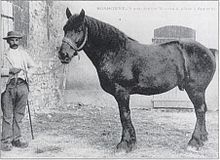Extinct breed of horse
.mw-parser-output .hidden-begin{box-sizing:border-box;width:100%;padding:5px;border:none;font-size:95%}.mw-parser-output .hidden-title{font-weight:bold;line-height:1.6;text-align:left}.mw-parser-output .hidden-content{text-align:left}@media all and (max-width:500px){.mw-parser-output .hidden-begin{width:auto!important;clear:none!important;float:none!important))You can help expand this article with text translated from
the corresponding article in French. (August 2011) Click [show] for important translation instructions.
View a machine-translated version of the French article.
Machine translation, like
DeepL or
Google Translate, is a useful starting point for translations, but translators must revise errors as necessary and confirm that the translation is accurate, rather than simply copy-pasting machine-translated text into the English Wikipedia.
Do not translate text that appears unreliable or low-quality. If possible, verify the text with references provided in the foreign-language article.
You must provide
copyright attribution in the
edit summary accompanying your translation by providing an
interlanguage link to the source of your translation. A model attribution edit summary is Content in this edit is translated from the existing French Wikipedia article at [[:fr:Nivernais (cheval)]]; see its history for attribution.
You may also add the template ((Translated|fr|Nivernais (cheval))) to the
talk page.
For more guidance, see
Wikipedia:Translation.
Nivernais Bonhomme, a 5-year-old Nivernais stallion, at Rémilly in the Nièvre in 1919 |
| Conservation status | endangered |
|---|
| Country of origin | Nièvre, France |
|---|
|
The Nivernais is an endangered breed of heavy draught horse from the Nièvre area of central France. It is always black. It stands about 165–175 centimetres at the withers, occasionally up to 180 cm, and weighs 800–1000 kg.[1] The breed was created in the Nièvre in 1872 by the Comte de Bouillé by crossing black Percheron stallions with local Cheval du Morvan mares. A stud book was opened in 1880, and from that time the breed largely supplanted the Cheval du Morvan. The population declined from the 1950s following the mechanisation of agriculture, and in 1966 the stud-book was merged with that of the Percheron. Since the 1980s various efforts have been made to preserve the breed. Without official recognition in France, it is listed in DAD-IS by the FAO.

